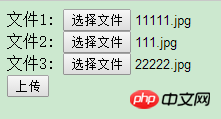SpringMvc 파일 업로드 및 다운로드
- 一个新手원래의
- 2017-10-09 10:11:191641검색
1. 먼저 jar 패키지를 가져옵니다.
 2. 그런 다음 다음과 같이 applicationContext.xml에 업로드 및 다운로드 구성 파일을 추가합니다.
2. 그런 다음 다음과 같이 applicationContext.xml에 업로드 및 다운로드 구성 파일을 추가합니다.
<!-- 文件上传的配置 -->
<bean id="multipartResolver" class="org.springframework.web.multipart.commons.CommonsMultipartResolver">
<!-- 指定所上传文件的总大小不能超过200KB。注意maxUploadSize属性的限制不是针对单个文件,而是所有文件的容量之和 -->
<property name="maxUploadSize" value="200000"/>
</bean>
<!-- 该异常是SpringMVC在检查上传的文件信息时抛出来的,而且此时还没有进入到Controller方法中 -->
<bean id="exceptionResolver" class="org.springframework.web.servlet.handler.SimpleMappingExceptionResolver">
<property name="exceptionMappings">
<props>
<!-- 遇到MaxUploadSizeExceededException异常时,自动跳转到WebContent目录下的error.jsp页面 -->
<prop key="org.springframework.web.multipart.MaxUploadSizeExceededException">error</prop>
</props>
</property>
</bean>3 좋습니다. 다음 JSP 페이지: upload.jsp
1 <form action="upload.do" method="post" enctype="multipart/form-data"> 2 文件1: <input type="file" name="myfiles"/><br/> 3 文件2: <input type="file" name="myfiles"/><br/> 4 文件3: <input type="file" name="myfiles"/><br/> 5 <input type="submit" value="上传"> 6 </form>
4. 컨트롤러의 해당 Java 코드:
@RequestMapping("/upload.do")
public String upload(@RequestParam MultipartFile[] myfiles,HttpServletRequest request) throws IOException {
for(MultipartFile file : myfiles){
//此处MultipartFile[]表明是多文件,如果是单文件MultipartFile就行了
if(file.isEmpty()){
System.out.println("文件未上传!");
}
else{
//得到上传的文件名
String fileName = file.getOriginalFilename();
//得到服务器项目发布运行所在地址
String path1 = request.getSession().getServletContext().getRealPath("image")+File.separator;
// 此处未使用UUID来生成唯一标识,用日期做为标识
String path = path1+ new SimpleDateFormat("yyyyMMddHHmmss").format(new Date())+ fileName;
//查看文件上传路径,方便查找
System.out.println(path);
//把文件上传至path的路径
File localFile = new File(path);
file.transferTo(localFile);
}
}
return "uploadSuccess";
}이 방법으로 웹페이지에서 선택한 이미지를 업로드할 수 있습니다.
5. 파일 다운로드 download.jsp: 여기서는 테스트 목적으로 사용자 이름을 매개변수로 직접 전달합니다:

a342d74c2459b749c88064982d6b750b下载5db79b134e9f6b82c0b36e0489ee08ed
6.
위 내용은 SpringMvc 파일 업로드 및 다운로드의 상세 내용입니다. 자세한 내용은 PHP 중국어 웹사이트의 기타 관련 기사를 참조하세요!
성명:
본 글의 내용은 네티즌들의 자발적인 기여로 작성되었으며, 저작권은 원저작자에게 있습니다. 본 사이트는 이에 상응하는 법적 책임을 지지 않습니다. 표절이나 침해가 의심되는 콘텐츠를 발견한 경우 admin@php.cn으로 문의하세요.
이전 기사:퀵 정렬을 구현하는 방법다음 기사:퀵 정렬을 구현하는 방법

